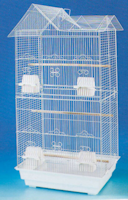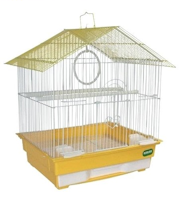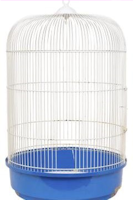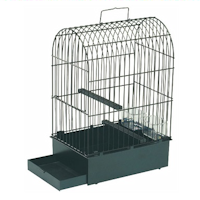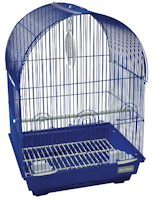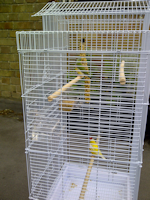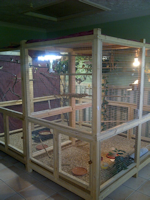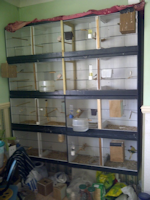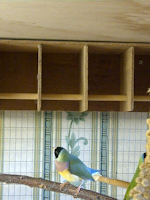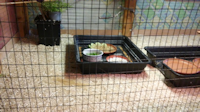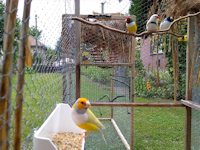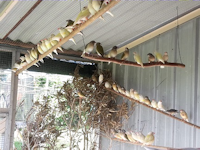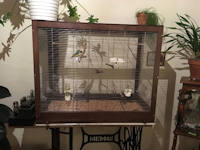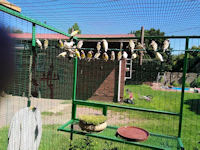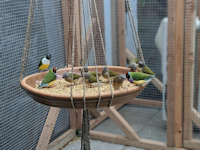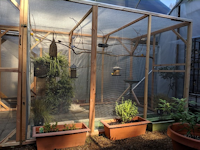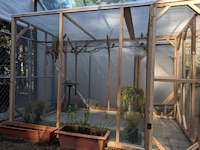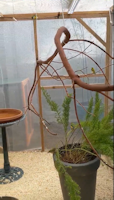Environment
Introduction
The type of cage or aviary where you plan to keep your gouldian finches and where it is located will play a vital part in their mental as well as physical well-being. Firstly there are types of cages that are not suitable for any kind of finch to be housed in, most aviaries are usually suitable due to their size, but some can harbour many unnoticed problems. Tall thin cages are not healthy because finches fly side to side, not up n down. The best type of cage are elongated with a minimum height of 18 inches, the wider, the better, so they can use their wings. On the right are some cages which are not suitable for gouldian finches, the reasons are obvious.
All the cages (Figures 1 - 5) are not suitable for any kind of finch to live in. They are OK as a transportation cage, hospital cage or to show a bird for a short period of time, but that is all. These type of cages are wired all around and have no safe place to hide from predators. Figure 1. & Figure 3., are cages that concentrate on height rather than width, leaving no room for flight. Figure 2, 4. & Figure 5. Have neither height nor width, there is no room to fly, little room for perches and most have wired bottoms which are not suitable for any bird.
Figure 6. Is one of my photos, the cage which is unsuitable to house finches is being used to take up to 2 birds at a time, so they can spend some time out in the sun. These birds are kept indoors in a large aviary where sunlight is limited. Any cages left outside with birds in are never left unattended due to predators. They can spend from 1 hour up to several hours a day lapping up the direct sunlight, with half of the cage shaded on hot days. Try not to leave cages unattended because birds in small cages are easy prey.
Figure 7. Is a photo of my indoor aviary, it comes complete with spacious room, correct lighting, heating. Feeders, baths and drinkers are positioned so that perching birds are unable to defecate in to them to help avoid the spread of any bacteria that 'maybe' present. I have used mostly natural perches from trees that are considered safe to use, and some dowels were used which have since been replaced with natural branches.
These type of cages (Figures 1 - 6) are advertised and sold as finch/canary cages, but in reality they are only good for a pretend bird such as a stuffed toy. It is criminal to even consider allowing your bird to spend its whole life in a cage like the ones mentioned above, and if you plan on doing so then I suggest looking for a different kind of pet such as a goldfish. The well-being of your birds is paramount and to help achieve this they need room, lots of room.
The bigger, the better even if you only have one pair of gouldian finches, give them plenty of room to fly, explore, play, roost, bath and feed. All these places can not be in the same area, or it is considered cramped conditions. Gouldian finches will often begin to exhibit signs of Stargazing (often misdiagnosed as twirling) when in cramped conditions or if perches are too close to the top of the cage. Although your gouldian finches may spend a lot of time sitting in their same favourite spot, they will have periods of flying for exercise.
Cramped conditions can cause depression, serious weight loss, loss of appetite, signs of madness, spending a lot of time clinging to the wires on the side of the cage, Illness, lethargy, stress, inability to fly when finally let out of the cage (cage-bound). I have seen far too often people posting photos of their birds in their cages only to discover their cages are too small. I hope this section will help educate those who do use tiny cages or those who are thinking about getting a small cage. Trust me when I tell you, if your birds are in a small cage, they are not happy birds!.
The shape of their housing is really not important at all, what is important is the size of the area (width x length) also the headroom (height). Aviaries are usually measured in feet (ft) whereas cages are measured in inches depending on what country you are in. Cages for gouldian finches should be a rectangular shape, 36 inches long min, 18 inches high and 14 inches wide. The width is always the most important for their flight room. An aviary is usually a much larger cage and the size can be as big as you want, bigger the better.
I found the best type of cage for gouldian finches are the ones with a wooden back, top and sides and bottom. I always remove any trays and block the holes because if you get an infestation of mites, the first place they hide is under the tray. The media I use for the floor in all my cages are hemp chips which have no smell, absorbs all moisture plus it is easy to clean not to mention it is also very cheap. You can use plain paper if desired, but avoid newspaper because some of the ink used can be poisonous to your birds. You can use other types of wood chips but never use wood shavings, sawdust, sand, or you will have problems.
Avoid wired bottom cages, these cages cause a lot of problems with birds. It is common for them to lose toes or feet and in some cases lead to broken legs or wings because they get stuck in the wires. Imagine having no shoes or socks on and walking on a wired mesh all day long, that is how it is for your birds, and it can also cause arthritis, cramps and other deformities. Bumble-foot / Tassel foot is quite common in birds kept in wired bottom cages, they start off as sores and then become infected but left untreated the bird can easily lose their whole foot / leg.
When we talk about environments for our birds, there are two types of environment to take into account, 1. The environment within the cage / aviary and 2. The environment outside the cage / aviary. Both being of equal importance when setting up a cage or aviary, the best place to start is with the outside environment, meaning the room in which they will be placed or if it is outside.
You need to think about where you are going to put it first, will it be indoors? Will it be outdoors? If indoors, what room will it be placed in? Will it be a sunny location? Will it be a cold or windy location, will there be fumes or a lot of foot traffic? Will there be animals which could get at them? Will it get too hot for them? Will there be enough light and ventilation? Will the cage / aviary be in the way of you?. For me, the first thing on my mind when housing a cage or aviary is fumes. I never put a cage or aviary anywhere near a kitchen because there is always a risk of burning food/pans also that is the usual place where chemicals are stored and risk of fires.
It is never a good idea to keep a lot of birds indoors, especially if you suffer from asthma or have any kind of breathing difficulties. The dust over time in a closed location such as a room can cause what is known as bird fanciers lung, which left unchecked can lead to serious human health issues. A good cleaning regime outside the cage / aviary as well as inside should help keep this under control. I always clean inside the cages first, then outside. Every few months, use a bucket of water and a some sterilizing solution, then get a cloth or sponge and wipe down all surfaces and walls in the room to keep the dust in check.
The second environment is the inside of the cage / aviary where the birds will live. This should be cleaned as often as possible and the smaller the cage the more frequent it will need cleaning. You will need to organize where you will place your perches and never place them too near the top, or it may cause stargazing. Avoid placing food dishes, drinkers or baths under a perch, or they will poop in them, risking the spread of any bacteria or parasites. Avoid plastic perches, although easy to clean they do their feet no favours. Avoid perches with sandpaper as these will make their feet sore over time and does not sharpen their claws. Always use real perches such as branches, but check the safe lists of trees first to make sure the branches are OK to use.
Gouldian finches like a lot of perches, they like swings, they like foliage (fake or real), they like privacy perches / roosting perches, they like space to fly, and they hate over crowding. They do not like bathing in dirty water, if the water is dirty they will often sit next to the bath and just look at it hoping you will take the hint. Scrub that bath and give them fresh water daily, if the weather is hot then change it several times a day for them. If they have no access to direct sunlight or can only get sun through the glass of a window, they will need a UVB light (supplemental lighting). These are special lights designed for reptiles and birds which produce light in the UV spectrum and provide vitamin D. Without vitamin D your birds will begin to show many odd symptoms such as weakness, loss of ability to fly, unable to perch, loss of weight and many other symptoms. Never use a UV light, it must be UVB, which is designed for birds. More about lights can be found in the lighting section.
Glass and plastic will block out the UV rays from the sun, this is why supplemental lighting is required if birds are kept indoors. Avoid locations where there are drafts, these spots will cause huge problems for your birds, including deaths. Avoid placing an aviary or cage in a room where you have carpet, carpets are perfect hiding places for mites and lice. Never allow a damp spot in the cage to persist, such as a leaky drinker, leaky bath. Any dampness or wet spots should be dealt with promptly. Rust should never be present at any cost, if you see any rust then deal with it right away. If you plan to decorate the room where you hope to keep your birds, then either use harmless paints or remove the cage / aviary from the room until the fumes have gone. Avoid painting your cage or aviary with paints that contain heavy metals or oil based paints, those birds who peck at paints can die from heavy metal poisoning or other chemicals within the paint.
I like to keep a small heat lamp in the cage/aviary, sometimes just being a simple 40watt incandescent light, this is great for a day when it gets a little cold. It is also a good way to detect if there are any early illnesses with your birds. A gouldian that is always found to be sitting under the light is usually suspected of being ill in some way, usually they will sit for a short period to warm up then fly off to do other things, but those who sit constantly all day under the light should be health checked. Make their environment interesting for them, give them lots to do so they do not become bored, boredom leads to fights or illness.
The floor of the cage or aviary should never be left bare, or it is hard to remove the build up of their droppings. You can use plain paper, wood chips (I use hemp chips for cleanliness), straw, dried / cut grass. The floor should be kept clean all the time because this is where their droppings will fall, and quite often you will find them on the floor pecking around at the droppings. Pecking at each other's droppings is one of the quickest ways of spreading bacterial infections, germs or parasites.
Cold, damp, mouldy and draughty rooms should be avoided for keeping any types of bird for obvious reasons, clean, bright rooms with a stable ambient temperature are ideal locations. Although this section seems more dos and don't s, it does highlight many of the common problems birds face when being housed by their keepers. I have seen some people keep birds in rooms where black mould is present, a clear health hazard even to humans.
Cages like those in Figure 1 - 6., are likely to have wired bottoms which is usually a removable panel, I always remove them because it's common for birds to get caught up in them. They make it difficult for the bird to stand on, cause Bumble foot / Tassel-Foot and usually droppings will stick to the mesh. Usually the keeper will pull out the tray and clean it, forgetting to clean the mesh bottom where the birds will peck. I hear countless stories of birds being found dead on the bottom of these cages where they have become trapped in the bars or have lost or broken limbs where they have become snagged only to fight to break free.
Many of the photos on the right, apart from Figures 1 - 6) are either my own cages/aviaries or from other kind-hearted people who have submitted their photos to us. As you can see, serious finch keepers look after their birds well and provide an adequate environment for their pet finches. These people have taken the time to think of their bird's needs and have provided not only a decent environment, but have also kept it clean and tidy. It really takes little effort to go that little bit extra, and it makes all the difference not only to the birds but also for you. I had thousands of photos submitted by our members, of which most were very impressive, but sadly I can not fill this page with them all. I was impressed at how creative some people got when constructing their aviaries, and I could clearly see they were putting their bird's health and well-being first.
Small cages will encourage diseases, parasites and are hard to maintain, so the bigger, the better. Perches should be plentiful with some foliage to play/hide in or nest in when their breeding season arrives. Finches do not do so well in cages and I have always believed that finches are NOT cage birds at all but rather an aviary bird requiring a lot of room to fly as some species are territorial. Aviaries need less cleaning whereas cages need more frequent cleaning, but it also depends on how many birds you have. Aviaries should never be built where it is windy and should be half shaded from the hot sun and shielded from any winds. The aviary should be shielded from the rain where possible, or at least half of the aviary should be kept dry at all times. Fresh running water fountains are fine, but should be filtered, and the water changed on a regular basis to avoid encouraging bacteria or parasites. Food should never be placed anywhere near the water as it will either become contaminated or it will contaminate the water. Food and water should never be placed directly below their perches, or they will likely contaminate it with their droppings as they perch above.
Cages Figure 1 - 6 are ideal for either transporting birds, using as a hospital cage, for temporary segregation or for photographing. They have no real other use at all. If you plan on buying one like those then please do not think about keeping your finch in that cage for long or the bird will probably eventually die. Birds also get bored and being kept in such a small environment offers no challenges, no mental stimulation and no much-needed exercise.
